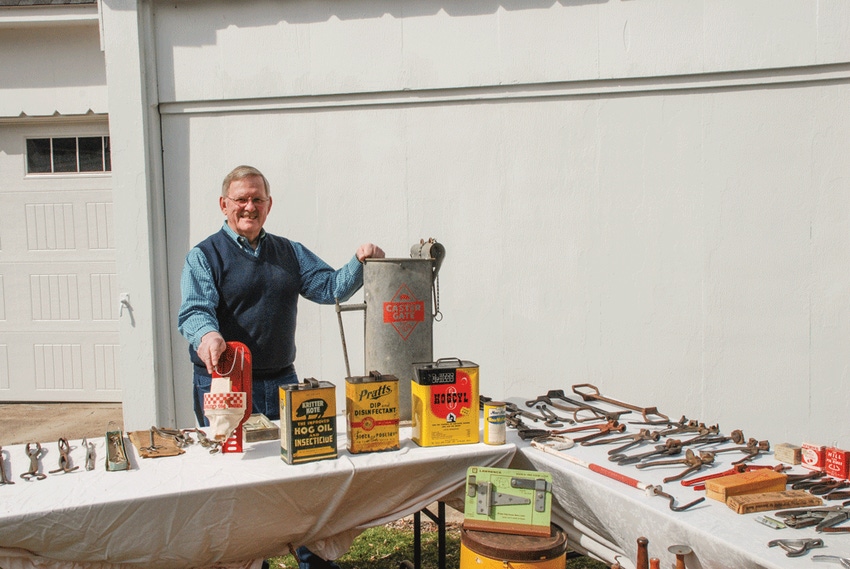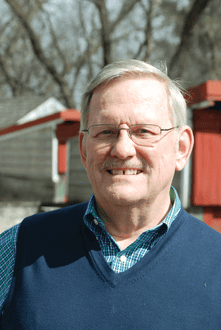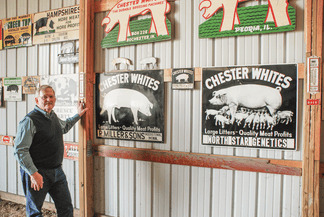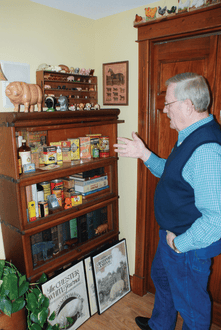2016 Pork Master: Dale Miller
The Masters of the Pork Industry are a very special, handpicked group of pork industry leaders. These are their stories.The Masters share their personal stories and philosophies about life, their careers in the pork industry and their visions for the future.They are professionals, entrepreneurs and family-based pork industry enthusiasts whose dedication and wisdom are sure to inspire young and old as they tackle the challenges and opportunities that lie ahead in an ever-changing global pork industry.


National Hog Farmer first chose Masters of the Pork Industry in 2006, a year after the magazine celebrated its 50th year of publication.
The introduction to the feature stories on that inaugural class said the Masters “are a very special, hand-picked group of pork industry visionaries. Their accomplishments, dedication and visions provide insight and some words of caution for those involved in the business of producing quality pork.”
Dale Miller wrote four of those initial Masters’ features, as well as many others before he retired as the National Hog Farmer editor in 2013. Since he was part of the team that developed this annual feature tradition, it seemed only appropriate that he should now also be featured as a Master, finding himself on the other side of the interview table and camera lens.
To many in recent memory, Miller was National Hog Farmer, and his legacy continues.
Miller joined the National Hog Farmer staff as an associate editor in 1973, fresh out of the University of Minnesota, where he graduated with a bachelor of science degree in animal science. “When I interviewed with Neal Black, I had to confess that my journalism training was somewhat limited,” Miller recalls. “Neal told me, ‘I can teach you to write, but I can’t teach you the hog business.’”
And Miller did know the hog business. Raised on a hog and dairy farm south of Morristown, Minn., which is about an hour south of the U-M St. Paul campus, Miller went the route of most farm youth of the day as a member of the local 4-H club. He focused on purebred swine in his 10-year 4-H career, highlighted by showing the Champion Chester White barrow and being named Champion Swine Showman at the 1965 Minnesota Market Livestock Show, and he was the Champion Swine Showman at the 1968 Minnesota State Fair. Miller went to high school at the Southern School of Agriculture in Waseca, Minn.
You could say that Miller bleeds white — as in the Chester White purebred breed. While in college, Miller spent three summers (1970-72) as a field representative for the Chester White Swine Record Association, as well as gaining some journalism experience on the editorial staff of the Chester White Journal.
While Black taught Miller the journalism game at the National Hog Farmer, the young, aspiring writer’s reputation grew in the industry as did the magazine that he would call home until 2013. In 1993, he replaced Bill Fleming to become only the fourth editor in the history of the National Hog Farmer. Miller credits Fleming with also helping shape his writing style, as Fleming brought a more conversational tone that paired well with Black’s newspaper style. “I give them both credit because I became a blend of their styles.”
“Neal was a workhorse, too,” Miller says of Black. “He expected a lot, but he was generous with his praise, too. … From that standpoint, I learned his work ethic, which was a local newspaperman work ethic.”
Miller’s parents, Roland and Lillian Miller, also taught him the importance of hard work. Miller says the success he achieved while at National Hog Farmer took discipline and hard work. “If I’ve accomplished a lot or even a little in this industry, it was because we worked hard at it. And we had a really good team when I was there. The magazine enjoyed a lot of success because we all worked hard, and it meant a lot to us. There’s no other way to say it, we enjoyed the people and the producers, and what they were doing.”
One of the people that Miller enjoyed working with was Joe Vansickle, who joined the National Hog Farmer staff in 1977 and stayed until his retirement in 2014. “Joe was so good at swine health reporting,” Miller says. “If there was something going on in swine health, Joe was on top of it.”
Front row seat
That team had a front row seat to the evolution of the swine industry during their tenure at the magazine.
“One thing that amazed me in my 40 years was how resilient pork producers are, how adaptable the pig is to new technology, with the different housing systems, even different feed,” he says from his home near Hampton, Minn., about 30 miles south of the Twin Cities. “The pig is a very flexible, dynamic type of animal that can adjust to so many different ways of taking care of them. When I first came into this industry, most of the sows were in open lots, and they were fed along fence lines, and it was kind of craziness when they were fed. Dominant sows can be mean, leaving the more submissive sows without the nutrients needed to carry a litter.
“As time went on, I got to see the evolution of moving sows from pastures to group housing to individual stalls. These changes ensured that sows wouldn’t hurt themselves or each other. At this same time, we saw the transition from natural breeding to artificial insemination, which lends itself to stall housing. Heat detection can be tricky, but that has been mastered. AI technology has evolved to be pretty much fail-proof and foolproof, but it still takes a certain technique and ability, and an understanding of a sow’s reproductive tract.”
Science has become a larger part of pork production since the time Miller started his writing career. “It wasn’t particularly sophisticated when I came in in the early 1970s, but it has evolved to be very scientific and sophisticated, with science leading the way to new technologies and efficiencies. Our ability to track the many facets of pig production continues to guide producers toward greater efficiency, sustainability and, hopefully, profitability.”
Just as the U.S. swine industry changed, so has National Hog Farmer. When Miller started, the magazine was feature-oriented, with more general articles about producers’ production methods and facilities. But as the industry evolved with more science and technology, Miller thought it would be best if the pages of National Hog Farmer mirrored that change. “I’m proud that National Hog Farmer evolved with the industry and became more scientific,” he says. “I think it filled a need as the industry became more science-based. There are a lot more master’s degrees and Ph.D.s in the industry than there used to be, and a lot of them are working in hog barns.”
The magazine’s evolution, with that of the industry, birthed some of the projects that brought the most pride to Miller, and coming to the top are the biannual Blueprint issues, which began in 1985. “I think the Blueprints are the strongest product that National Hog Farmer has because it allowed us to delve deeply into a topic,” he says. “We got a lot of feedback from people that they really liked the Blueprint issues. People kept them; they may have gotten rid of every other issue, but they didn’t throw these out.”
Miller was also on the ground floor when the Environmental Stewards of the Pork Industry Program started in 1994. National Hog Farmer co-sponsored this program with the pork checkoff until the program was discontinued in 2015. The program has been replaced with an individual being named America’s Pig Farmer of the Year to be the spokesperson for the industry.
“I think there was merit to the Environmental Stewards program, to recognize not only the technology, but also the people who adopted that kind of stewardship in to their operation,” he says.
As the U.S. swine industry changed, producers had to change with it by improving their knowledge base. Miller helped develop and produce a number of production-based posters that helped guide producers and their employees in key operating procedures.
“These posters were also well-received. They helped fill a void,” he says. “They were basic in many ways, but they displayed husbandry topics such as assisted farrowing, proper injection sites and methods. The gilt selection poster took on a life of its own — it was meant to be one poster but became three with the help of Ken Stalder at Iowa State. The heat detection poster helped AI technicians understand the importance of taking the time to do it right. The posters were a lot of work, but the response to them told us we were providing valuable information that could be applied on the farm.”
The series of production posters has grown to double digits and posters have been translated into Spanish, Finnish, Japanese and Chinese.
Just as Miller attempted to educate his hog industry readers, he realized that he also was on a lifelong learning curve. “A great part of this job was that I got to keep learning,” he says. “I got a good education at the University of Minnesota, but the real education came on the job, working with the university scientists and the best and brightest hog production people from all over the country.”
In addition to the university researchers and professors, Miller says he is indebted to the producers for opening their barns and minds to him over the years. “This is a great industry to be a part of,” he says. “I was truly impressed and appreciative of how willing producers are to share their knowledge. Producers are very generous with their information.”
Miller is not married, has one brother and two sisters, but he considers the producers and many other friends in the swine industry to be a part of his family. “Most of my close friends are from the industry,” he says.
As with anyone who is good at their job, there comes a time when they have offers for other employment, and Miller was no different.
“Over the years I had offers to leave, but I never had an offer that I felt was going to be as fun or as enjoyable as what I had with the pork industry. For one thing, National Hog Farmer was always seen as ‘the Bible’ of the pork industry, it was so highly thought of, so going from that to anything else didn’t have a lot of attraction to me,” he says. “Nobody was ever more fortunate than myself to get on the magazine that I did. It was just the perfect job for me. I don’t know how anybody could have had a more perfect career than I did … I thrived under the pork industry. I thank God every day for giving me that opportunity.”
Having spent as much time as he did with the swine industry, you knew Miller wasn’t going to leave cold turkey. After his retirement from National Hog Farmer, Miller took a part-time job with the Minnesota Pork Producers Association as producer membership and outreach coordinator where among other duties he was to travel Minnesota to communicate the benefits of membership and participation in the Strategic Investment Program.
Miller maintains a connection to the production side of the business through a small herd of Chester White sows. In 1977, he started with eight to 10 sows, which grew to 20. Farrowing facilities were a converted chicken house. “I farrowed two groups in the winter and two in the summer. With a full-time job and commuting 30 miles, it just got to be too much. Then I started to back it off.”
First, he partnered with Lee Todnem, a college friend who lived near Milaca, Minn. Todnem bred and farrowed the sows, and Miller would raise the pigs at his Hampton farm. Miller and Todnem worked together for about 20 years.
A similar arrangement was made with Steven Resler from Owatonna, Minn., about six years ago. Chester White sows are housed at Resler’s farm, about an hour south of Miller’s farm. Miller and Resler purchased a much-needed nursery barn together to help pigs get off to a better start. In the spring, Miller brings barrows and gilts to the Hampton farm to be fed out during the summer. Barrows are processed by a local locker plant, and the best gilts are kept and returned to the sow herd.
Industry concerns
 Through Miller’s involvement with actual production and with his MPPA job, he keeps in tune with the issues facing the industry.
Through Miller’s involvement with actual production and with his MPPA job, he keeps in tune with the issues facing the industry.
“I’m concerned about the influence that the animal welfare community is having on production practices in the hog industry. I don’t expect that to go away, and I don’t expect them to change their attitude toward what they feel, I guess, is their good cause.”
He says the activists’ lack of understanding prevents them from realizing that the way producers raise pigs today has evolved and is for the betterment of the pig. “And in some cases, it makes working with them a lot easier and safer, especially in a state like Minnesota where winters aren’t only harsh on people, but also on livestock.
“I just don’t know what will happen to the industry if the pork industry goes the way of the poultry industry, where the trend seems to be cage-free housing. I guess that’s manageable, but it’s certainly not as efficient or sustainable — at least not by my definition of sustainability.
“What would happen if there comes a day when pigs must have access to the outdoors?” he asks. “Pork production would go down, pork prices would go up to the consumer. You just wouldn’t be able to raise as much pork if some of their wishes came to be.”
Miller shares that Stan Curtis, an animal science professor at the University of Illinois, “was one of most interesting people I met while at National Hog Farmer.” Curtis was a pioneer in animal well-being research. “He spent his career trying to get into the mind of a pig,” Miller says.
“Stan instilled in me the opportunity to think in those terms, to try to understand what the welfarists were thinking. Not that he sided with them, he was just trying to explain why pigs do what they do, to try and understand the psychology of the pig. I witnessed cases where if sows are given the option to be in their stall or in the pen, they will choose their stall, because that’s their space. They know it’s their space, they’re going to be taken care of there, there will be food and water.”
Miller spent a lot of time in gestation barns shooting pictures, and he says he never once saw a sow that resisted going into a stall. “Turning around is no big deal to a sow, but to convince someone of that otherwise, we haven’t figured that out yet.”
Antibiotic availability and what it means to the industry is another big concern of Miller’s. “We do have a huge challenge with the antibiotic issue. It’s not that I don’t think that we can raise pigs without antibiotics after they are 6 to 8 weeks old. I am concerned about young weaned pigs where they haven’t developed their full immune systems. It’s not unlike raising a child; if they get sick, you make sure they get the medications that they need.
“Physiologically, pigs are so similar to humans. Parents make sure their children get the vaccinations when they need them to ensure they stay healthy. That’s exactly the mindset of pork producers as they care for their pigs.”
Miller admits there are positives that have come from the outward pressure of the antibiotic issue. “This has helped producers with their biosecurity and their working relationship with their veterinarian. As always, pork producers will work with the veterinary community and swine researchers to master methods of raising pigs with better immunity and less need for medication. However, young pigs, like young kids, can get sick, and when they do, the proper thing to do is make sure they get the care and medication needed for them to thrive.”
He also thinks technology will advance to develop farm-specific vaccination programs to help minimize the medications needed to maintain pig health. Another exciting development is the gene editing procedures announced last fall in the battle against porcine reproductive and respiratory syndrome, although Miller believes the commercial availability is still quite a few years off.
“I think there’s a convergence coming with gene editing. As those and other technologies are also being talked about in human medicine, I wonder, if gene editing is OK to suppress or eliminate diseases in people, will it also be OK for animals?” he says. One of the biggest challenges with gene editing is to help people understand that new genes are not being added; they’re just editing what’s there.
Since this is the pork industry, Miller also believes that more work should be done to study meat quality issues. “In the end, it’s affecting consumer acceptance of the pork,” he says. “We say we’re focusing on quality, but in truth there is less pork quality work being done today. There are fewer meat scientists at the universities. I feel it’s something the industry should pay more attention to.”
Look ahead by looking back
When the Masters program was developed, Miller says the intent was to feature forward thinkers who had made their mark in the industry. With one eye on the future, it never hurts to look back at how we got here.
Miller has seen the national pork organizations change over his time with the magazine. “The organizations have changed a great deal, out of necessity,” he says. “On the pork checkoff side, they do a real good job of research, promotion and education. On the pork advocacy and regulatory side, the National Pork Producers Council does yeoman’s work to represent the interests of pork producers.”
In Miller’s eyes, the pork industry has had “an uncanny ability to find the right leaders for the right time. I have watched it happen again and again.” He points to one such example when Orville Sweet came to the National Pork Producers Council in 1979. “He was from the cattle side. He had been president of the American Polled Hereford Association [since 1963]. He didn’t know pigs, but he was the right person at the right time for NPPC. He got people focused on the right issues and pork promotion. He was really good for the industry at that time.”
Miller believes the people who are successful in the leadership of the NPPC and the pork checkoff have an appreciation for the history and the grassroots. “They need to understand how the industry evolved. Orville learned it and appreciated it.”
Pork history appreciation
 As you enter Miller’s home, it’s not hard to see where his loyalties lie. There are pigs everywhere. Sure, there are other animals featured, but pigs dominate his interior decorating. “Collecting all things pig has evolved over time,” he says. “In high school I had friends and relatives that were into antiques.”
As you enter Miller’s home, it’s not hard to see where his loyalties lie. There are pigs everywhere. Sure, there are other animals featured, but pigs dominate his interior decorating. “Collecting all things pig has evolved over time,” he says. “In high school I had friends and relatives that were into antiques.”
His pig collecting, especially the historical collections, “came with my time at National Hog Farmer be-cause I wanted to preserve as much of the history as we could, and I could see that some of it was slipping away from us, and that concerned me.”
Knick-knacks, books, feed posters, pig prints — you name it, chances are Miller has it, and if he doesn’t have it, he wants it.
Stashed in outbuildings around his farm you will find a different assortment of hog tools, ear-notchers, hog ringers and snouters, pig holders for castrating, obstetrical tools, parasite control products, feeders and feed supplement packages, just to name a few that take a viewer down hog production memory lane. Miller enjoys the history behind each piece that he has accumulated through auctions or visits to antique shops on his travels, but he wants to share his collection with others.
He envisions donating his collections to a museum “or some type of interpretive center” so that young producers and the general public can better understand the amazing evolution of the U.S. pork industry.
“I’m concerned about losing some of that really important history and artifacts. You don’t want to dwell on the past, and everyone knows that, but it’s really good to recognize your past, especially past leaders who helped get us to where we are today. I’d like to help preserve as much of that as we can.”
Miller is currently working with a small group of industry leaders and the Silos & Smokestacks group in Iowa to identify a site for his and others’ pig treasures and the rich heritage of the U.S. hog industry.
Miller has been a big part of the U.S. swine industry’s past, and he’s looking to preserve some of that for the future generations. That merits the title of Master.
About the Author(s)
You May Also Like



